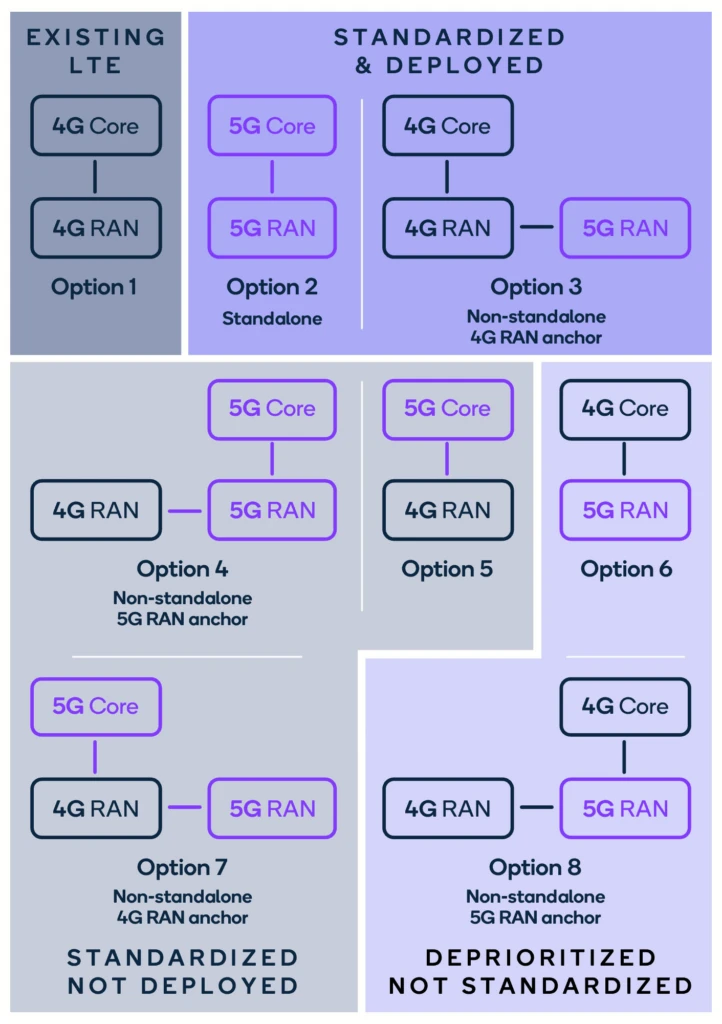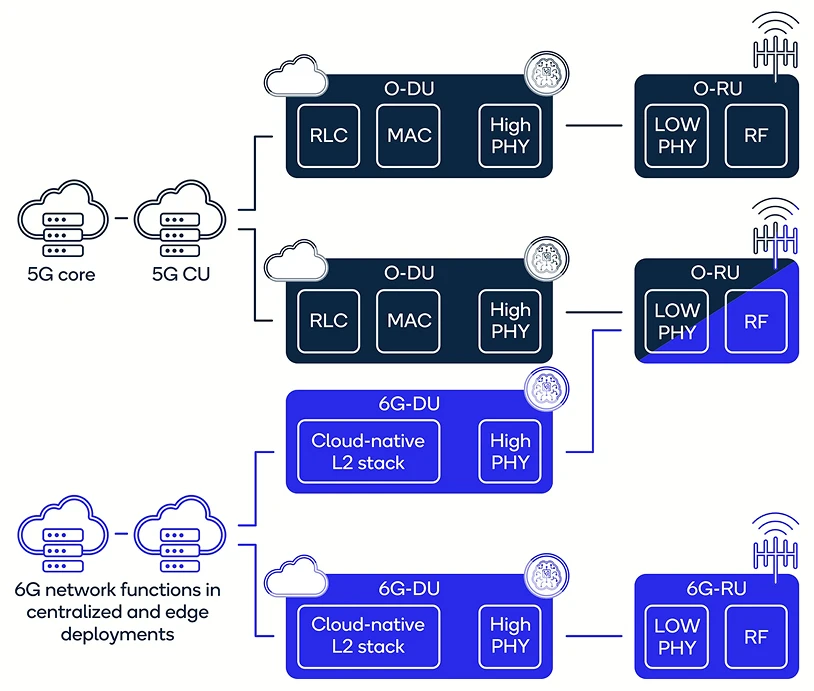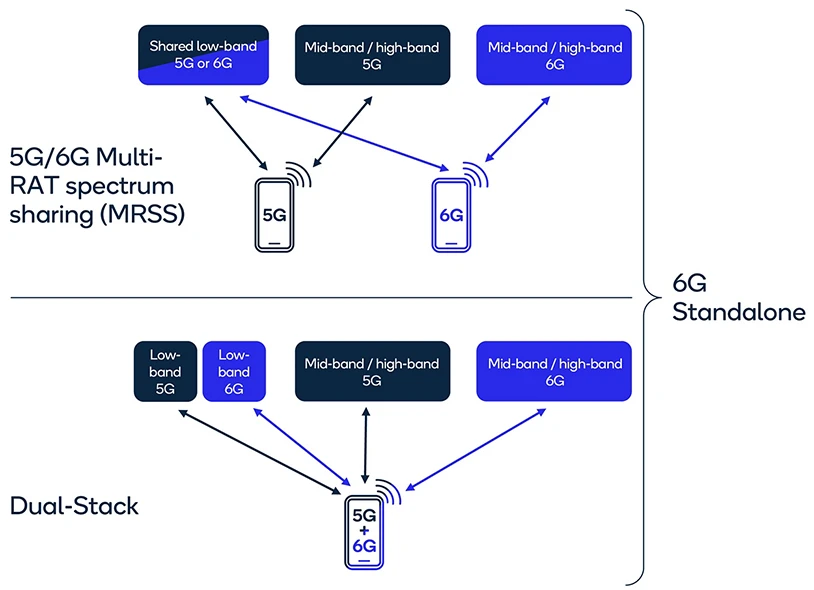There may be many ways to launch a 6G network, but the 5G experience suggests that choosing the fastest route may not be the wisest choice in the long run.
Welcome to the second installment of 6G Foundry, where we take a closer look at key considerations when transitioning from 5G to 6G. Lessons learned in the evolution from 4G to 5G make it clear that prioritizing 6G standalone solutions will accelerate new revenue opportunities and the delivery of innovative services. We also discuss the importance of spectrum sharing, infrastructure reuse, and different approaches to ensure a smooth and cost-effective transition. So how can operators transition from 5G networks to 6G? Read on to find out.
Learning from 5G adoption and the transition from 4G to 5G
Transition from 4G to 5G. As shown in Figure 1, 3GPP considered two solution families, splitting into seven new options on top of the existing LTE architecture. Five of the options were ultimately standardized based on operator input, but only two of them were commercially deployed. The transition from 5G to 6G must avoid ecosystem fragmentation and the resulting market disruption. It can meet the evolved needs of the 3GPP ecosystem while more effectively applying the limited resources of network operators, infrastructure vendors, and technology providers.

Figure 1. 4G to 5G migration options.
In the transition from 4G to 5G, 5G had two main families of options: Standalone (SA) and Non-Standalone (NSA). As shown in option 3, 5G NSA relies on existing 4G RAN and core to anchor new 5G radio access network (RAN) connectivity and was considered to be the best option to accelerate 5G commercialization based on the needs of operators at that time. 5G NSA allows operators to leverage existing 4G network as a coverage layer to provide a stable user experience and also allows operators to launch a subset of 5G services before the 5G core network is available during the 5G RAN deployment. As a stepping stone, the new 5G RAN is designed to be forward compatible with the addition of a 5G core network at a later time, allowing smooth network migration to 5G SA in the future, for example for end-to-end services such as network slicing. Although 5G SA (shown in Option 2) was standardized in Release 15 just six months after 5G NSA, operator momentum towards adopting 5G SA came much later and there is still a long way to go.
While NSA has accelerated early 5G deployments, the existence of two deployment options for operators to adopt 5G (NSA and SA) has created a divide in the operator ecosystem and led to uneven levels of progress towards 5G SA. The strong desire for early 5G NSA deployments has delayed the implementation of key elements that depend on 5G SA networks, including many features in subsequent 3GPP releases (Release 16 and beyond).
Experience from the 4G to 5G transition shows that decisions regarding the 5G to 6G transition may impact the ease of implementation and deployment of 6G features across multiple releases of 3GPP standards. Therefore, based on lessons learned from 5G, when accelerating 6G deployment is no longer a top priority, the preferred long-term strategy for ecosystem evolution is to deliver 6G SA solutions first. Furthermore, standalone 6G RAN and core networks should be the primary design by limiting the need for interoperability with legacy generations, benefiting from the latest and future advancements in cloud, artificial intelligence (AI), and other technology enablers, and maximizing platform capabilities and revenue opportunities for new use cases and verticals.
Impressive early experiences accelerate 6G adoption
The opportunity to adopt technology and platform advancements has driven 3GPP standardization efforts for each new generation of mobile connectivity, with the goal being to improve performance with each generation across key metrics.
- User-perceived throughput improvements enable new user experiences for new use cases.
- Increasing network capacity through the addition of new spectrum and improved spectral efficiency maximizes the return on operators’ spectrum investments.
- Low end-to-end latency enables new use cases that require a more responsive network.
Just as 4G service outperformed 3G at its launch, 5G service is launching with devices that can combine 4G and 5G network capacity through dual connectivity, delivering performance beyond 4G. Naturally, users have come to expect measurable improvements with each generation of wireless technology, especially in user-perceived throughput.
6G standalone is expected to improve latency and reliability, and introduce new monetizable services leveraging AI/machine learning and radio frequency (RF) sensing. However, for most deployments, it is unlikely that on day one of 6G operations, enough new spectrum will be allocated for 6G to exceed 5G capabilities alone across the network’s coverage area, which is a critical factor for users. Therefore, by leveraging 5G deployments, 6G services will have enough spectrum available to meet user expectations for higher throughput as well as the higher throughput requirements of advanced services and new use cases. As a result, similar to the transition from 4G to 5G, legacy generations and the spectrum they occupy will continue to play a critical role in both the rollout of 6G and the enhancement of the 6G user experience.
Prioritize intergenerational spectrum sharing for a smooth transition
Another factor to consider is that when it comes time to deploy 6G, operators will likely have a mix of 5G SA and NSA deployments. 6G deployments will include new spectrum, but will likely also leverage existing 5G bands from the start. To ensure a smooth transition to 6G using existing 5G bands, it is important that 5G bands are dynamically available for wide-area deployment of 6G without disrupting existing 5G services. As in the past, solutions will rely on the aggregation of spectrum across 5G and 6G (e.g. sub-6 GHz and upper mid-bands) to deliver the overall throughput required to meet user expectations. From a device and network perspective, how operators deploy new generations across new and existing spectrum assets will be key to ensuring a smooth generational transition.

Figure 2. Hardware pooling for 6G deployment using 5G O-RAN Radio Units (RUs).
Prioritize infrastructure reuse and scalability for network evolution
Many network operators are investing heavily in 5G networks and want to extend the payback period (ROI). In fact, the guiding principle adopted by the Next Generation Mobile Network Alliance in its 6G position statement is that 6G should not inherently trigger a hardware refresh of the 5G RAN infrastructure. The migration path from 5G to 6G should incorporate strategies to reuse as much infrastructure as possible, including software, hardware, and RF systems, to reduce deployment costs.
For example, operators may want to allow existing 5G band radio units (RUs) to be reused for 6G and share fronthaul interfaces on RUs in bands common to 5G and 6G. Hardware pools must be able to multiplex resources to support 5G and 6G deployments and accommodate new elements for 6G evolution, such as computing resources and specialized RF baseband. Cloud platforms must provide the scale required to host simultaneous 5G and 6G services while offering operator services common to different generation networks, such as IMS voice. Limiting the impact on legacy networks (e.g., by not requiring 5G and 6G interoperability as was required for NSA) can further reduce deployment costs.
Complementary approaches: multi-RAT spectrum sharing and dual stack
Based on the above considerations, MRSS and dual-stack are 5G to 6G transition solutions that jointly address diverse deployment requirements. Together, they offer complementary approaches based on best practices for spectrum and infrastructure transition.

Figure 3. Complementary approaches to reusing 5G spectrum for 6G.
Realizing wide-area 6G coverage with MRSS
Implementing MRSS in existing 5G bands (using CP-OFDMA compatible waveforms) enables efficient deployment of 6G wide area networks. Additionally, using MRSS in sub-1 GHz bands enhances 6G robustness by providing access to wide-reaching and reliable lower band anchors, complementing 6G’s new higher frequency bands that provide greater capacity. As a result, MRSS combined with inter-band aggregation can significantly improve the overall coverage of a 6G-only network.
Dual stack improves user experience in regions where MRSS is not (fully) implemented
In the early stages of 6G deployment, there may be areas where 6G-only operation is still insufficient as MRSS is not deployed or is only enabled on a subset of the available bands. To improve user experience in such areas, dual-stack devices can connect to 5G and 6G simultaneously using independent transceivers. This allows the device to operate simultaneously and independently on two radio access networks. Implementing 5G+6G dual-stack devices simplifies the deployment of new 6G technology for operators by managing the complexities of interoperability between 5G and 6G on devices capable of simultaneous operation, while improving user experience by combining 5G and 6G network capacity for devices that require it. The resulting user experience is similar to that of a dual-SIM dual-active (DSDA) device user with dual data connectivity. This provides the most economical way to deploy a standalone 6G network with the scope of benefits mentioned above. Dual stack extends the ROI period by easily reusing the broad coverage and existing services such as voice of mature 4G and 5G networks, and enables the aggregation of entire spectrum bands without impacting legacy networks, continuing the inter-generational increase in the overall spectrum bandwidth that devices can access.
Dual-stack separates 6G RAN and traditional RAN with two independent connectivity stacks, eliminating the need for coordination between them. Applications can aggregate the two connections (for example, to improve throughput or reliability) or use operator policies on the device to control how services are accessed. Enabling coordination at the core can further improve the user experience.
Making the Right Choices for a Successful 6G Future
Early choices on 5G to 6G migration can have a lasting impact on future 6G capability adoption, the continued evolution of 6G networks, and the ROI period of existing 5G networks. To reap the benefits of agility enabled by cloud-native network platforms, 6G standalone solutions should be prioritized. Additionally, complementary approaches such as MRSS and dual stack can improve user experience and enable widespread access from day one with 6G standalone networks. By adopting these strategies, operators will be in the best position to meet user expectations for 6G while minimizing costs and disruptions to legacy networks.
6G networks must be able to evolve to support future 6G capabilities and new use cases. Consensus on a 6G standalone foundation will foster a unified ecosystem and deliver higher returns on the effort and investment required to deploy 6G.


